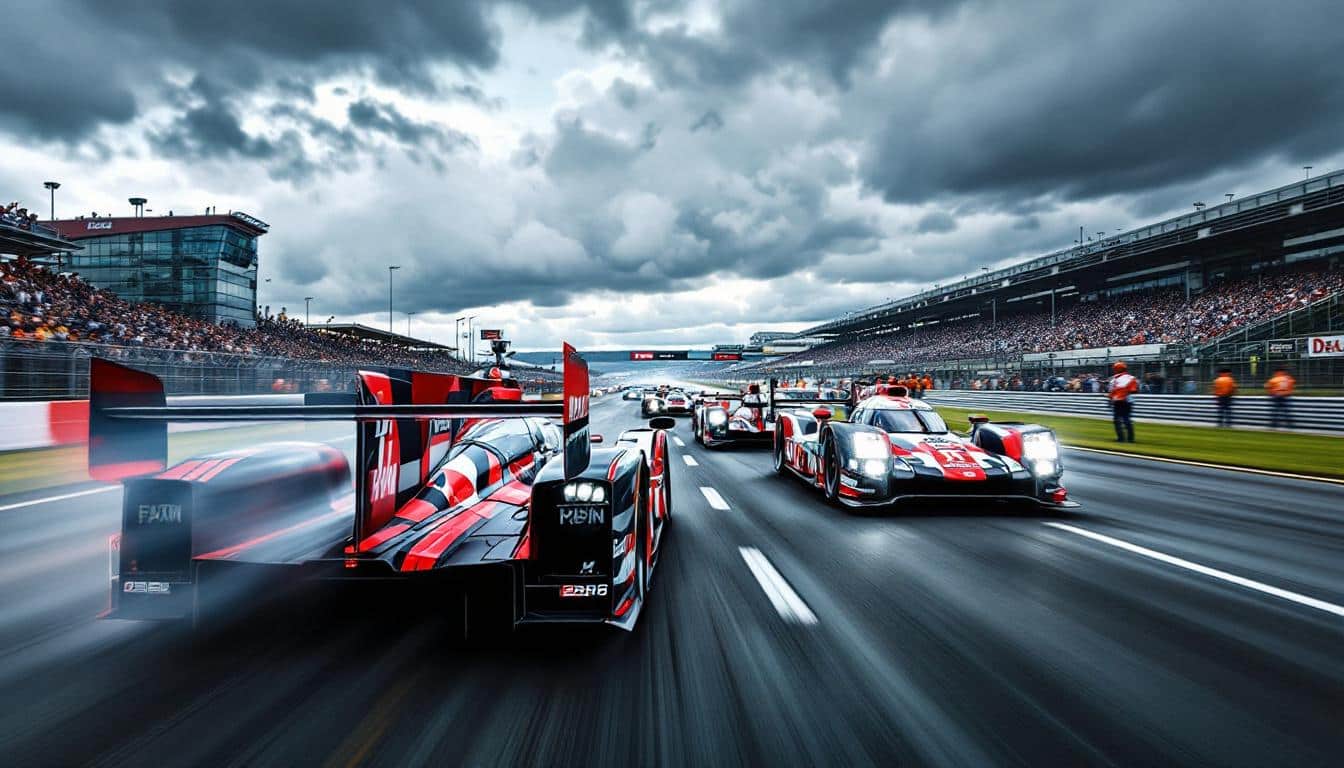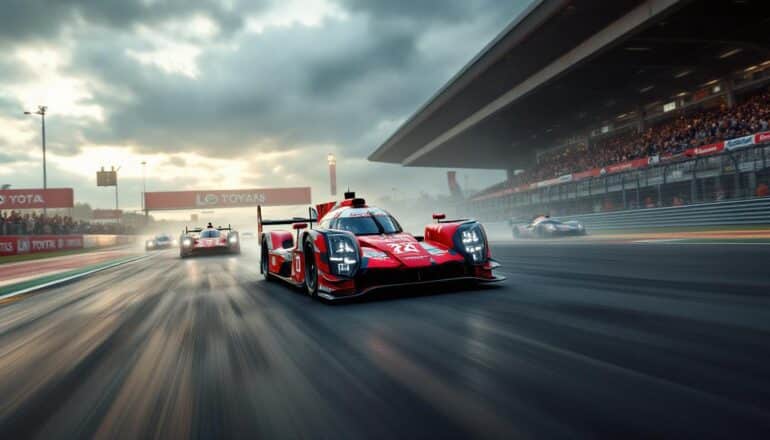The roar of engines, the thrill of speed, and the pursuit of victory—this is the essence of motorsport.
As the 24 Hours of Le Mans unfolds, the stakes are high, and every contender dreams of grandeur.
Yet, amidst the glamorous chaos, not every team finds their moment in the spotlight.
In a recent performance at Le Mans, Toyota Gazoo Racing faced a harsh reality check. Technical director David Floury openly criticized the FIA’s Balance of Performance after witnessing a disappointing outing, where their cars finished fifth and fifteenth. The dominance of Ferrari served as a painful reminder of the competitive landscape, leaving Toyota lagging behind in speed and performance. Acknowledging the shortcomings of their strategy, Floury’s candid reflections shine a light on the challenges that come with racing at this elite level. It’s a gritty tango of power and precision, where the desires for victory clash with the stark truth of performance gaps.

When it comes to endurance racing, the illustrious Le Mans 24 Hours stands as a beacon of innovation and competition. However, recent remarks from Toyota Gazoo Racing’s technical director, David Floury, have highlighted a troubling trend in the race’s dynamics—namely, the apparent division into what he refers to as a ‘two-class race.’ This situation has emerged due to the FIA’s controversial Balance of Performance (BoP) mechanism, designed to ensure equitable competition among various manufacturers. But is it truly serving its purpose, or has it led to a disparity that skews the spirit of the race?
Understanding the Balance of Performance is crucial because it aims to level the playing field by adjusting the performance of competing cars. However, as Floury pointed out, this year’s competition at Le Mans left Toyota struggling to compete effectively, highlighting systemic issues with the current regulations. After finishing in 5th and 15th place, the pain was palpable for the team that had aspirations of victory. “Clearly, we haven’t reached our goal,” Floury stated bluntly, underscoring the frustration that stems from being outperformed on a grand stage.
Delving into the details, Toyota’s GR010 Hybrid faced challenges throughout the race, contrasting starkly with the performances of leading competitors, particularly the Ferrari team. Floury noted a clear divide in performance: “It was a two-class race, one with the cars that had top speed and one with the cars that had no top speed.” His statement encapsulates the core issue; the objective of creating an even playing field may be lost amid complex regulations. Drivers were not only racing against each other but navigating an artificial barrier that restricted the full potential of their machines.
How did the FIA’s BoP affect Toyota’s performance at Le Mans?
At the heart of the Balance of Performance lies a series of adjustments made to each vehicle’s performance attributes, aimed at creating a more competitive environment. This year’s Le Mans 24 Hours, however, seemed to favor certain teams, leading to a situation in which Toyota struggled to find its footing. Floury expressed deep disappointment in how the BoP affected the team’s competitive output.
Throughout the race, the Toyota GR010 Hybrid was beset with limitations that were particularly evident in speed traps, where the team registered significantly lower performance levels compared to rivals like Ferrari, who reached blistering speeds of 349.0 km/h. Thus, when examining how the BoP played out in practical terms, it becomes evident that not all adjustments effectively mitigate the disparities between the competing machines. Instead, in this case, they may have exacerbated them.
Floury’s poignant observations emphasize that the BoP created an environment where performance was not contingent on car capabilities but rather on regulatory limits. “On pure performance, there was no way we could compete.” This stark recognition speaks volumes about how regulations can shape race outcomes, often in unexpected ways that lead to feelings of inequity and frustration among competitors.
What does Toyota’s struggle at Le Mans reveal about future racing dynamics?
The implications of Toyota’s experience at Le Mans extend far beyond a single race. It raises critical questions regarding the sustainability and fairness of the competition in endurance racing. As Floury indicated, the race became an exercise in survival rather than a pure display of racing prowess. With teams like TJota Gazoo Racing expressing dissatisfaction, the FIA faces an uphill battle to refine the BoP system to ensure it facilitates competition rather than stifles it.
This situation invites scrutiny of the regulations applied, as Toyota was not operating at optimal levels—highlighted by both strategic execution and car reliability. Floury’s remarks about being placed in a class with brands that underperformed further emphasize the competitive imbalance that can arise from the BoP. Regardless of preparation and tactic, once at the mercy of regulatory limitations, the margin for error is razor-thin.
While this year’s race may have produced some notable moments, it also illustrated that the sport must remain vigilant against the pitfalls of overregulation. As competing interests converge and technology rapidly evolves, maintaining the integrity of the racing experience is paramount. If the objective is to enhance competition, then further refinements to the BoP are necessary to address disparities and foster environments where each vehicle can strive toward its fullest potential.
How do fans perceive the impact of BoP on endurance racing?
Fans of endurance racing have always embraced the thrill of competition, and a critical part of that experience involves the balance between excitement and fair play. The sentiment towards the Balance of Performance regulations among fans is mixed; many appreciate the intentions behind such regulations, yet they are increasingly vocal about their belief that these adjustments detract from the raw spectacle of racing.
As Toyota and Ferrari’s contrasting results at Le Mans highlight, racing fans yearn for a scenario where each team can showcase its capabilities devoid of regulatory constraints. Floury’s commentary that “the #8 car had a solid race… but then…” epitomizes the frustration shared by many supporters of motorsport. If regulatory adjustments obstruct the natural competition that fans cherish, then the essence of endurance racing may be lost.
Audience reactions on various platforms underscore a desire for transparency and clarity in how performance measures are determined. It’s no longer just about winning; it’s also about how teams engage with the regulations and each other in the quest for success. The hope is that regulators will listen to these concerns while forging a future where both innovation and classic racing spirit coexist harmoniously.
In sum, Toyota’s critique of the Balance of Performance exposes significant friction points within the racing community and hints at the need for deep introspection and review. The goal should always be to ensure that every participant—manufacturer, driver, and fan alike—feels a sense of fairness and engagement in the spectacle that is endurance racing. Each race should serve as a platform for the best and the bold, where performance speaks louder than regulation—a principle that ultimately fuels the passion behind motorsport.


